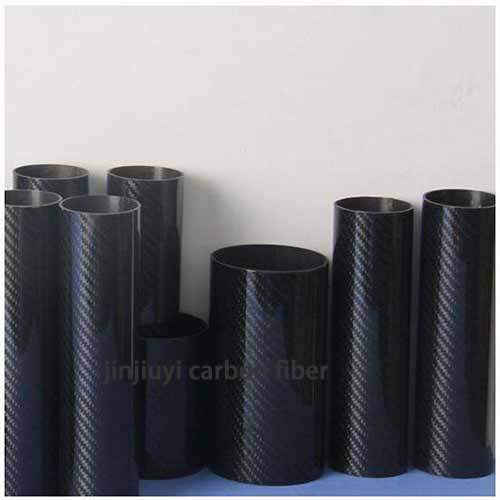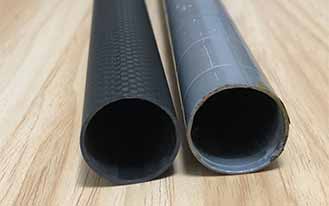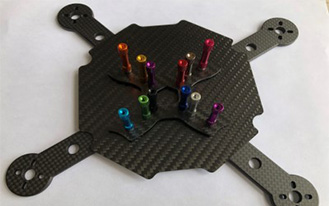Pipes have an important role in manufacturing. Pipes' material needs vary depending on the setting. Stainless steel, aluminum alloy, magnesium alloy, plastic, Teflon, and other pipe materials are often used. Carbon fiber round tubes are seeing increased application as carbon fiber materials are being widely used in the manufacturing sector. Round tubes made of carbon fiber and aluminum both have a reputation for being very lightweight. See if you can guess which one is the best option.
Carbon Fiber Round Tube
Carbon fiber round tubing is produced by heating, curing, and pultruding carbon fiber composite material that has previously been submerged in a styrene-based polyester resin (twisting). During production, carbon fiber may be formed into a wide variety of shapes and sizes using a wide variety of molds, including circular tubes, square tubes, sheets, and more. During production, 3K may also be packed for use as a surface coating or for aesthetic purposes.

Pros and Cons of Carbon Fiber Round Tubes
1. Strong tensile properties; carbon fiber can withstand forces up to 3000 mpa, or six to twelve times those of steel.
2. Little bulk and minimal weight. Less than a quarter as dense as steel.
3. Carbon fiber round tubes are used in a wide variety of applications, including kites, aircraft models, light brackets, PC equipment spindles, etchers, medical equipment, sports equipment, and other mechanical devices due to their high strength, long life, corrosion resistance, light weight, and low density. Dimensional stability, electrical conductivity, thermal conductivity, tiny coefficient of thermal expansion, self lubricating, energy absorption, and shock resistance are just a few of its many impressive qualities. A wide variety of properties, including high specific modulus, fatigue resistance, creep resistance, high temperature resistance, corrosion resistance, wear resistance, etc., are present.
4. While its excellent tensile strength outweighs the drawback of its high conductivity ( cm - 1.5 10-3) in certain contexts (for instance, the tensile strength is kg/mm2 - 400 when computed in 12000 filament units).
Aluminum tube
In the context of nonferrous metals, an aluminum tube is a hollow metal tube that has been extruded from either pure aluminum or an aluminum alloy. Closed through holes of varying wall thickness and cross section may be supplied in either a continuous line or a rolled configuration. It finds applications in transportation (automobiles, ships, airplanes, etc.), manufacturing (aircraft, trains, etc.), agricultural (farming), manufacturing (electromechanical parts for
It's a kind of heat-treatable, ultra-sturdy duralumin. It spot welds well and has a modest degree of ductility in the annealed state but hardens significantly in the quenched and heated states. Intergranular fractures often occur in aluminum tubes during gas welding and argon arc welding; aluminum tubes are easily machined after being subjected to quenching and cold work hardening, but are difficult to deal with in their annealed condition. Not much thought was put into making it corrosion-resistant. To make a surface more corrosion-resistant, many people choose to utilize anodic oxidation, paint it, or cover it with aluminum. This material is also suitable for use in dies.
Pros and Cons of Aluminium Tubes
1. First, welding technology is an advantage of aluminum pipe. Thin wall copper aluminum pipe welding technology suited for industrial production is the central technology of switching from copper to aluminum for AC connecting pipe, and it is recognized as a world-class challenge.
2. Because the refrigerant does not include water, the inner wall of the copper aluminum connecting tube will not corrode over time, which is an advantage in terms of service life.
3. Benefits to energy efficiency increase with decreased heat transfer efficiency (or increased insulating effect) in the connecting pipeline between the air conditioner's internal and outdoor units.
4. Very good bending performance, lightweight, and simple to set up and relocate
Carbon Fiber Round Tube Compare With Aluminum Tube

1. When comparing weight, the carbon fiber round tube is lighter than the aluminum tube, which is still rather light. When comparing tubes of the same diameter and wall thickness, a round tube made from carbon fiber may be around 30 percent lighter.
2. If you're looking for a tube with superior strength, go no further than a carbon fiber round tube. T300 grade carbon fiber round tube has a tensile strength of up to 3500 MPa, which is comparable to that of an aluminum tube.
3. Longevity: a phrase that covers a lot of ground. Carbon fiber round tubes are more long-lasting and have greater resilience to wear and tear due to their high resistance to acids and alkalis, as well as their resistance to impacts and creep.
4. In the event of bending, the carbon fiber round tube itself is brittle, meaning it will not bend under low pressure and will immediately collapse under high pressure, rendering the damage irreparable. The aluminum alloy pipe is easily deformed under pressure but may be straightened out again after being processed.
5. While carbon fiber is strong and lightweight, a circular tube's resistance to high temperatures is severely lacking. The spherical tube is made of epoxy carbon fiber, which can endure temperatures up to 150 degrees Celsius. In most cases, the circular tube made of thermoplastic carbon fiber won't become hotter than 250 degrees Celsius. Aluminum has a melting point of 660 degrees Celsius. Aluminum alloy has a lower melting point than this, but it will still be much higher than the carbon fiber round tube.
6. Carbon fiber and a resin matrix make up a carbon fiber round tube that expands and contracts with temperature. Carbon fiber has excellent creep resistance. Carbon fiber round tubes do not experience thermal expansion and cold contraction when a resin like epoxy resin functions correctly in a low-temperature environment. Because of the widespread issue of thermal expansion and cold contraction in metal materials, aluminum tube is not suitable for usage.
7. The carbon fiber round tube's shear resistance is substantially lower than that of aluminum tube because of its strong co-directivity and ordinary counter-directivity.

Pulished on Oct. 23, 2023

Pulished on Feb. 02, 2023